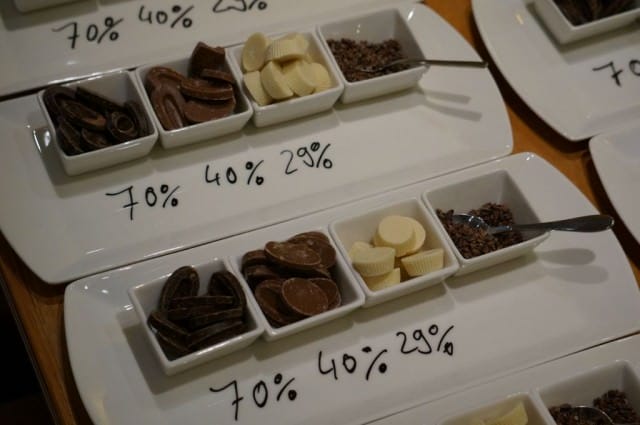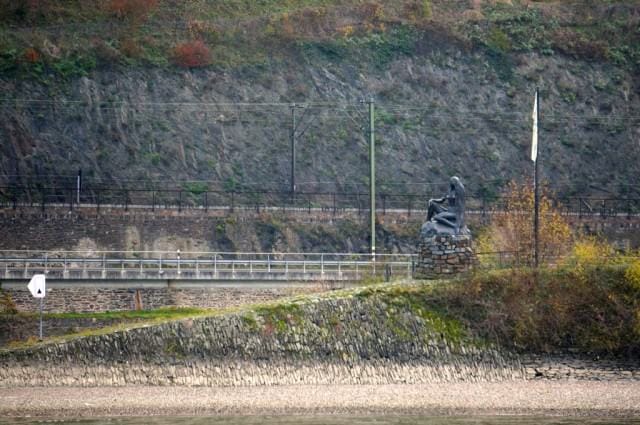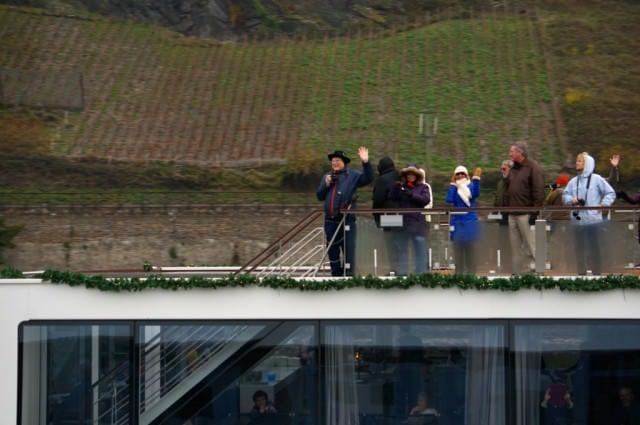
Early this morning we sailed away from Koblenz, having overnighted in this confluential city where the Rhine absorbs the Moselle and meanders to the North Sea. Most of the morning was shrouded in mist, which seemed somehow appropriate as we would soon be passing the mystical Lorelei. The rocks, and the eponymous maiden who sits like a queen on them, have lured many sailors and boats to peril. A-ROSA Silva would, of course, skirt danger and arrive as scheduled in Rüdesheim.



I particularly enjoyed my last day on board A-ROSA Silva. At 10 p.m., I fly from Frankfurt to Buenos Aires, a 14-hour flight that begins a new adventure, exploring Antarctica.
On A-ROSA Silva, however, it was time to say good-bye to the many good people I had met. There were Canadians, citizens of a nation that should be nominated as the world’s friendliest people; there were Americans, my fellow countrymen; and then there were Texans, Californians and New Yorkers — yes, also Americans, but … well, you know how they are.
I enjoyed meeting them all and hearing what they had to say about A-ROSA Silva. Most of the people I talked with had only good things to say about the vessel, the crew and their experiences. In fact, one consistency among all guests who shared their thoughts with me was the praise they had for the crew. Indeed, the men and women of A-ROSA Silva did an outstanding job. They are highly trained and professional, but more than that, they are personable and accessible, and they seemed genuinely eager to please, whether that means crafting a beautiful latte macchiato or preparing a bicycle for an afternoon of touring (both are free of charge, by the way).



Guests also praised the dining experiences. The presentation and quality of the food was outstanding, as were the wines, many selected by Mario Braun, who works in the corporate offices for A-ROSA but who was on board to help guide A-ROSA’s transition. Up until this year, A-ROSA had only catered to European guests, but a new initiative, headed by David Morris International, offers select sailings to North American guests only. Braun and his crew were on board making sure that they had fine-tuned the A-ROSA product so that it met the needs and desires of North Americans. From my conversations with guests on board, Braun succeeded, except for perhaps a few trivial details, which I will get to in a moment.
Braun, who also has experience with food and beverage for Seabourn (hence, his polish and professionalism), held a wine-tasting last night. I counted more than 20 people attending, and we all left with new knowledge about German wines and the pleasure of having been entertained and educated — and pleasantly buzzed.
While Braun has experience with Seabourn, a few chefs and galley staff who I spoke with on A-ROSA Silva have experience with Silversea. That does not surprise me given the quality and presentation of the cuisine.

A few experienced travel agents on board had some valid complaints. During the sit-down dinners (as opposed to buffets), for example, the menu presented only one choice of main course. It wasn’t the case that there was only one choice, but diners weren’t made aware that there were “always available” selections. That could be easily remedied by amending the menus. Still, a valid criticism, and one I am sure A-ROSA will correct.
The take-away, however, is that the dining experience, both in the quality of the wines and the cuisine as well as the service, was of a high standard. I failed to meet anyone who was disappointed. On the contrary, I talked with a few experienced travelers who said that the cuisine was the best they had experienced on a river cruiser.



Another plus that I heard from my fellow A-ROSANS was related to the value. A-ROSA is deliberately under-pricing its product to create brand awareness in the North American market. The all-inclusive aspects sit well with guests. Included in the cruise fare: gratuities (except for a few euros that you may want to tip your tour guides ashore), beverages (including sparkling wine, beer, wine, spirits, speciality coffees, soft drinks, bottled water and more), transfers between the airport and vessel, and tours (except for a few premium tours). A-ROSA also has the standard inclusions that most other river cruisers are now offering: free WiFi, bottled water in staterooms and more.
On the Rhone, A-ROSA offers lunch by the world renown Paul Bocuse. Company executives estimate the value of this event to be $150 per person. It’s complimentary for A-ROSA’s guests. See this link for a photo slideshow of our lunch there this past summer.
There is a lot more that I could say about the product, but I summed things up in an earlier report, so if you would like to read more, see Assessing A-ROSA Stella: 9 Differentiating Factors That Would Make Me Cruise Again.


We are fortunate to have so many good choices when it comes to exploring Europe (and beyond) by river. What many river cruisers want to know is what makes one company different from another. A good starting place is to become familiar with the companies that operate river cruises, and you can do that at this link.
For A-ROSA, and for now, the points of differentiation are 1) all-inclusiveness (others will begin in 2014, however); 2) exceptional value (the pricing is hard to beat); 3) the fitness and spa facilities (which in my experience are the largest on the rivers); 4) the quality bicycles (I know — I’ve ridden the bikes of nearly every cruise company that offers them); and 5) the large, heated pool (it was used by several people, even in December).
I’m sure there are a few other aspects that differentiate A-ROSA from its competitors, and I welcome readers to join the conversation in the comments section below.
At the moment, however, it is time for me to hit the “publish” button and close the lid on the laptop. I need to gather my things and trundle out to Gate 15 here at Frankfurt airport. There’s a big Lufthansa jet waiting to take me and a few hundred others across the equator and the Atlantic. I will be in Buenos Aires for less than 24 hours, which is fine by me. A real adventure awaits, the White Continent.
Tonight, as I am flying, I’ll reflect on pleasant thoughts of my river cruise along the Rhine and the good group of people I met. I hope to see them again on other cruises in other places on this beautiful planet, and if luck prevails, we may just meet on A-ROSA once again.

A-ROSA, Christmas Markets Cruise
| City/Port | Arrival | Departure | ||
| Day 1 | Frankfurt | Frankfurt is known for its “Manhattan skyline” with the Messeturm (convention tower) which is the highest building in Europe. The old imperial city is one of the most important trading and economic centres in Germany. Many important banks and the most important stock market are situated in Frankfurt. Frankfurt was the birthplace of J.W. v. Goethe and its many universities, theatre and museums provide a diversified cultural life. | 6 p.m. | |
| Day 2 | Speyer | Speyer is a historic old imperial city, which is situated on the left bank of the Rhine. From 1294 to 1797 it was a free imperial city, and the Imperial Diet met frequently in Speyer during that period. It suffered severe destruction in 1689 during the war over the Palatinate succession. The symbol of Speyer is the huge cathedral, one of the most important cathedrals built in the High Romanesque period. | 9 a.m. | 11 p.m. |
| Day 3 | Kehl/Strasbourg | From the Roman era up until the present day, Strasbourg has played a significant role and had an eventful history. The impressive buildings still bear testament to this today. Strasbourg is the capital of the Alsace and a European metropolis with many research-, educational- and cultural institutions; it is also the seat of the European Council of Ministers. | 1 p.m. | overnight |
| Day 4 | Kehl/Strasbourg | — | 7 p.m. | |
| Day 5 | Mainz | Mainz is a historic old town, a former Electoral residence, seat of an Archbishop and also the city of Gutenberg. The city is a focal point of the western end of the Rhine-Main economic region. Around 1450 Johannes Gutenberg, the inventor of printing with movable type, set up his press in Mainz. Points of interest are the St Martin and St Stephen cathedrals, the castle of Mainz and the Gutenberg Museum. | 9 a.m. | 11 p.m. |
| Day 6 | Cologne | Cologne, the old Cathedral city, is also one of the most important traffic hubs and commercial centres in Germany, with world famous trade fairs and a busy shipping traffic. Cologne developed out of a Roman colony and looks back on a history of more than 2000 years. In the Middle Ages it was one of the leading towns in Germany. The Second World War destroyed most of the inner city; these parts were rebuilt in a modern style. The landmark and emblem of the city is the Cathedral, a masterpiece of High Gothic architecture and one of the largest cathedrals in Europe. Other tourist attractions are the town hall, the Malakoff Tower, the St Martin Church and the old abbey. | 12 p.m. | overnight |
| Day 7 | Koblenz | Koblenz is not just where history meets modernity, but also where the Rhine meets the Mosel: at the “Deutsches Eck” (“German Corner”) the two rivers join each other in front of the equestrian statue of Emperor William I. | 2 p.m. | overnight |
| Day 8 | Cruising The Rhine | Cruising by the Lorelei & along the Mid Rhine after departure | — | 6 a.m. |
| Day 8 | Rüdesheim | Rüdesheim, an ancient little town, stretches along the Rhine under the hills of the Niederwald. The best vineyards are traditionally said to have been planted with Traminer vines by Charlemagne. The excellent local wines and the charming and varied scenery have enabled Rüdesheim to develop since the end of the 19th century into one of the busiest tourist and holiday centres on the Middle Rhine, with a host of friendly restaurants and wine taverns, particularly along the famous Drosselgasse. Rüdesheim has two castles – the Oberburg and the Vorderburg – both were built in the 12th century. | 2 p.m. | 9 p.m. |
| Day 9 | Frankfurt | 7 a.m. |



6 Responses
Thank you, and keep on enjoying the warm weather. I am off to Antarctica next. Brrrr!
I loved reading your report, thank you! I’ve only been on 2 river cruises , both Avalon and loved them. Won’t be doing winter though, I’m in Tucson!
Thanks, Ralph. Now that we’ve moved from Chicago to southern Calif., I think we’ll pass on winter cruising. Even our Antarctica trip was in its “summer” but we were dressed for the cold which was mainly in low 30s F. Not bad at all. Enjoy.
Love this comment:
“then there were Texans, Californians and New Yorkers — yes, also Americans, but … well, you know how they are.” !!!
Larry, Thanks for your note.
I would recommend cruising the rivers in winter, but only because my experiences have been so good.
Weather? Yes, it is cold. I have cruised the rivers at least five times in winter, and it has always been cold. We did see temps in the high 40s a few days on my most recent cruise, but mostly temps have been in the 30F to 40 range. No rain that I remember, but some sun and a lot of gray. A few gorgeous sunsets.
I enjoy the Christmas Markets, but after you’ve seen a few …well, I enjoy seeing Europe without the crowds more than the Christmas Markets. For repeat cruisers especially winter may be a good way to explore a different side of Europe.
But of course, nothing can beat Europe when it is warm, so maybe I would recommend it as something different and at an exceptional value. Airfares between the US and Europe are generally lower and cruise fares may be better (A-ROSA starts at $1499 per person).
Hope this helps.
Ralph, would you recommend the Christmas Markets tours in general vs. one in the spring, summer or early autumn? I am aware that many river cruises last year in the spring and early summer where negatively impacted by floods. But in general, after spending three years with the USAF in Germany in the late 70s, I remember Nov and Dec as being quite cold and damp. IMO, not worth the cost to see a few markets, when the beautiful countryside and cities could be seen in much more optimal conditions. Really looking forward, as I know you are, your visit to Antarctica. Our Lindblad/National Geo trip in 2012 was a great experience. Glad you’ve read up on Shackleton.